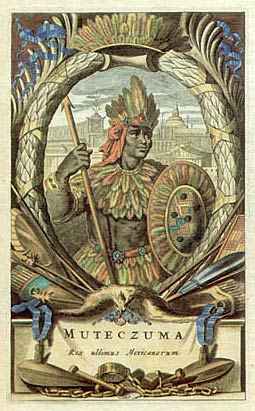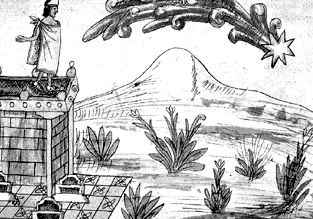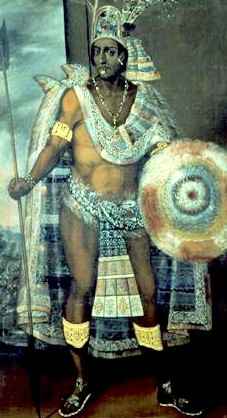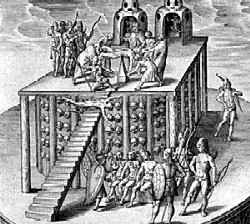|
Montezumaaka Moctezuma The funny thing about Montezuma isn't really that he was a deranged, despotic, cannabilistic, pedophiliac practitioner of human sacrifice with legendary diarrhea.
The funny thing about Montezuma isn't really that he was a deranged, despotic, cannabilistic, pedophiliac practitioner of human sacrifice with legendary diarrhea. Well, OK, that is pretty funny. But the really funny thing is how many towns, high schools and rotary clubs are named after the guy. There's Montezuma, Iowa; Montezuma, Georgia; Montezuma, Kansas; Montezuma, New York; Montezuma Castle National Park in Arizona; Montezuma, Costa Rica; Montezuma, New Mexico... The list goes on and on and on. What were these people thinking? Do they want you to think their town is full of cannibals? Are they proud of their explosive diarrhea? What was the runner-up name for the town? Hitler, New Mexico? Torquemada, Georgia? De Sade, Kansas? Montezuma was the emperor of the Aztecs in the 16th century—right about the time that the good times were coming to an end. (Montezuma is the Anglicized version of the Spanish Moctezuma, which is a Spaniardized version of one of those seemingly unpronounceable Aztec names.) While the coming of the White Man provides a convenient scapegoat for Aztec apologists, the fact is that Montezuma was not a barrel of laughs even before Cortez dropped the Conquistadors in his lap. Montezuma was a conquering king, who frequently waged war against his neighbors in a pretty successful effort to expand his empire. He kept the gods on his side with a regular regimen of human sacrifice. While the Aztecs had a long history of ritualistic human sacrifice, the art had never known a patron like Montezuma. At the time, such sacrifices were performed with ritual daggers atop the Aztec pyramids. According to some accounts, Montezuma sacrificed tens of thousands of prisoners at a time, which is a good trick considering each one had to be individually killed. A 1590 account detailed the procedure: "The usual method of sacrifice was to open the victim's chest, pull out his heart while he was still alive, and then knock the man down, rolling him down the temple steps, which were awash with blood." It wasn't the most efficient procedure. Who knows what Montezuma could have accomplished with a gas chamber, a guillotine, or a submachine gun? Apparently the gods were appreciative of all this bloodshed, because Montezuma apparently had a pretty good run, annexing several nearby kingdoms and allegedly running a virtual police state with an iron fist. Of course, it's difficult to know exactly how bad life under Montezuma was. As in modern times, the Aztecs were damned by some extremely convenient intelligence findings, which may have been more colorful that true. Hernan Cortez, leader of the Spanish Conquistadors, first met Montezuma in 1519, and his arrival was a big fucking deal. The Aztecs had a legend, you see, about the end of the world, in which a bearded white-skinned god would come to herald the apocalyptic end of Aztec civilization.
Worried, Montezuma made an extremely bad move. He sent truckloads of gold and baubles to Cortez as gifts, in an effort to dissuade him from coming any close to the Aztec capital of Tenochtitlan. Cortez saw these gifts and immediately thought "pussy." And Montezuma wasn't just any pussy, either. He was a fabulously wealthy pussy. Cortez ordered his Conquistadors to head to Tenochtitlan. Cortez needed a rationale to support the morality of his actions, something a little more sophisticated than "Me want gold." The Aztec practice of human sacrifice provided the perfect pretext, but Cortez went the extra mile in providing colorful tales of depravity, which were embellished to a greater or lesser extent.
Lured by easy pickings, Cortez was shocked, shocked to discover the horrors of human sacrifice. He found so much evidence of barbarism that no Spanish jury in the world could possibly convict him. There were human hearts nailed to the walls of temples, pyramids dripping with blood, half-eaten human bodies lying discarded in the streets, rampant sodomy, polygamy, dogs and cats living together, mass hysteria! Montezuma lavished Cortez with gifts of gold, fabrics and slaves in an attempt to placate the Conquistador. Although his men were reasonably happy with this largesse, Cortez had bigger plans and he ordered loyal troops to sink the ships in which the Conquistadors had arrived. With the only avenue of retreat eliminated, the Conquistadors reluctantly agreed to go ahead with the business of conquest. Cortez conquered some smaller cities first, and impressed their residents to fight in his war. Despite this, Montezuma welcomed the Conquistadors to Tenochtitlan with open arms and fabulous prizes. Cortez arrested the emperor using a small guerrilla force and attempted to use him as a puppet ruler, ordering up big heaping piles of gold for the Spaniards. Unfortunately, the Aztecs were getting mighty tired of both Cortez and Montezuma, whose weakness was now the object of open scorn. Assassins wounded Montezuma, who was put into protective custody. When Cortez ordered the Aztec temples defiled and that Christian icons replace the old gods, it was as much as the citizenry of Tenochtitlan could bear. At this awkward moment, the governor of Cuba, a longtime political enemy of Cortez, sent an arrest party to bring the Conquistador back home. Cortez marched out to meet the interlopers and soundly defeated them, recruiting the survivors to his own force. The end result left Cortez in a much stronger position, lucky for him, because the deputy he had left in charge of Tenochtitlan had taken it on himself to massacre a fair portion of the citizenry. When Cortez returned to Tenochtitlan, the hostilities mounted into open war.
The battle stretched on for days and then weeks, with the Aztecs waging guerilla warfare in the streets, while Cortez constructed engines of war to lay siege. Meanwhile, Montezuma was still in the Spaniards' custody. He had steadfastly rebuffed the Conquistadors' attempts to convert him to Christiantity or to give him medical treatment after the assassination attempt. After languishing in poor health for weeks, the Emperor Montezuma died on 30 June 1520; for all intents and purposes, the Aztec empire died with him. After 80 days of bloody battle, Montezuma's successor surrendered and the Spaniards looted Tenochtitlan. You would think the humiliation of overseeing his empire's conquest by a vastly smaller force would have been enough humiliation, but history wasn't quite done with Montezuma yet. In addition to having dozens of small towns and tourist traps named after him in order to entertain the White Man, Montezuma had one last indignity associated with his name. Montezuma reputedly had an affinity for chocolate, a delicacy invented by the Aztecs. According to some legends, he would drink as many as 50 cups of hot chocolate per day, often mixed with another Mexican delicacy, chili peppers. As you might imagine, this sort of diet will really clean out your G.I. tract. As a result, "Montezuma's Revenge" eventually entered the cultural lexicon as a polite way to refer to explosive diarrhea, ensuring that the last Aztec emperor would be most often remembered during one of life's most miserable experiences. Somewhere out there, Cortez is no doubt laughing his ass off. |
 A series of bad omens had reportedly occurred in the months before Cortez arrived to claim Mexico on behalf of Spain, including a strange comet sighting, a lightning strike on the temple of the Aztec war gods, the capture of a bizarre bird with mirror eyes. The combination of all these factors led to rampant panic that the time of the Aztecs was coming to an end.
A series of bad omens had reportedly occurred in the months before Cortez arrived to claim Mexico on behalf of Spain, including a strange comet sighting, a lightning strike on the temple of the Aztec war gods, the capture of a bizarre bird with mirror eyes. The combination of all these factors led to rampant panic that the time of the Aztecs was coming to an end.  The accounts of Aztec civilization that Cortez thoughtfully provided to posterity certainly justified any little violence he himself might have perpetrated. According to Cortez (and a learned Spanish monk in his employ), the Aztec city was a charnel house of unimaginable proportions.
The accounts of Aztec civilization that Cortez thoughtfully provided to posterity certainly justified any little violence he himself might have perpetrated. According to Cortez (and a learned Spanish monk in his employ), the Aztec city was a charnel house of unimaginable proportions.  The Spaniards stormed the Aztec temple, and a fierce battle broke out. Some Aztecs, seeing the futility of fighting the Conquistadors' superior firepower, opted for suicide. Others went down in a blaze of glory. Neither strategy was particularly effective.
The Spaniards stormed the Aztec temple, and a fierce battle broke out. Some Aztecs, seeing the futility of fighting the Conquistadors' superior firepower, opted for suicide. Others went down in a blaze of glory. Neither strategy was particularly effective.